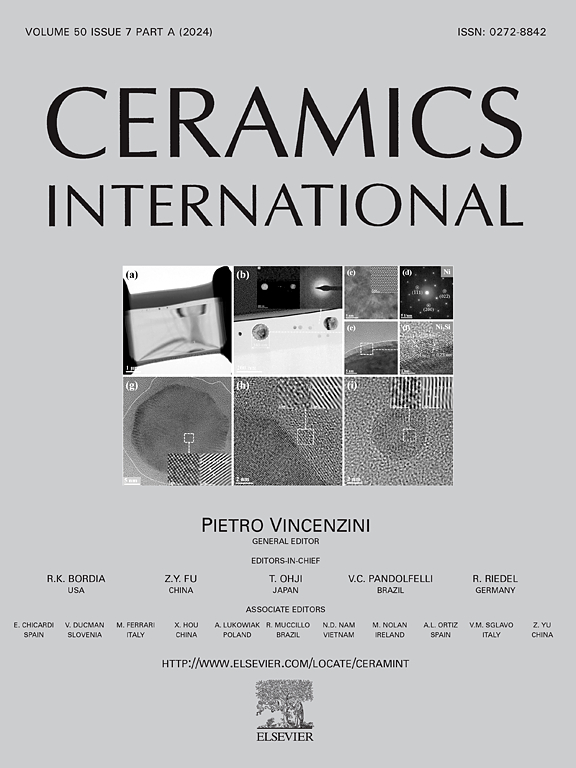SHS processes, structure and phase composition of hybrid compositional materials produced from (Al-Tiad)–(Ti-2B) system powder at different Tiad content
IF 5.6
2区 材料科学
Q1 MATERIALS SCIENCE, CERAMICS
引用次数: 0
Abstract
The paper studies processes of self-propagating high-temperature synthesis (SHS) in the (Al-Tiad)–(Ti-2B) system powder and the structure and phase composition of the obtained hybrid compositional materials, depending on the content of additional titanium (Tiad) introduced in the initial powder mix. It is shown that the higher Tiad content leads to the temperature rise and more intensive SHS processes. The Tiad content of 5, 10 and 30 wt% provides the formation of hybrid metal matrix composite Al–Al3Ti–TiB2. The content of Al3Ti phase in the SHS products increases with increasing Tiad concentration in the initial powder mix, while the content of the aluminum matrix reduces. Further growth in the Tiad content up to 50 wt% significantly modifies the phase composition of SHS products. The latter have no aluminum phase, but have new AlTi, cubic Al3Ti, and orthorhombic and cubic TiB phases. The paper proposes formation mechanisms of the structure and phase composition of synthesized hybrid metal matrix composites Al–Al3Ti–TiB2. It is supposed that these hybrid materials can be used as a hardening additive to the powder mix for the SHS products. Hardening additives can be utilized both in conventional powder metallurgy and selective laser sintering, selective laser melting. The best content of hybrid metal matrix composite Al–Al3Ti–TiB2 added to the primary material, varies between 5 and 10 wt%. It is supposed that at such a concentration, the material plasticity lies within the tolerable limits; its strength, hardness, wear resistance, and oxidation stability being grown.
不同Tiad含量下(Al-Tiad) - (Ti-2B)体系粉末制备杂化复合材料的SHS工艺、结构和相组成
本文研究了(Al-Tiad) - (Ti-2B)体系粉末中自传播高温合成(SHS)的过程,以及根据初始粉末混合物中添加钛(Tiad)的含量,所得到的杂化复合材料的结构和相组成。结果表明,Tiad含量越高,温度升高,SHS过程越强烈。当Tiad含量分别为5%、10%和30%时,形成了Al-Al3Ti-TiB2杂化金属基复合材料。随着初始混合粉中Tiad浓度的增加,SHS产品中Al3Ti相的含量增加,而铝基体的含量减少。Tiad含量进一步增长至50%,显著改变了SHS产品的相组成。后者没有铝相,但有新的AlTi、立方Al3Ti、正交相和立方TiB相。本文提出了合成的杂化金属基复合材料Al-Al3Ti-TiB2的结构和相组成的形成机理。推测这些杂化材料可作为SHS产品粉末混合物的硬化添加剂。硬化添加剂既可用于常规粉末冶金,也可用于选择性激光烧结、选择性激光熔化。混合金属基复合材料Al-Al3Ti-TiB2的最佳添加量为5% ~ 10%。假定在此浓度下,材料的塑性在容许范围内;其强度、硬度、耐磨性和氧化稳定性不断提高。
本文章由计算机程序翻译,如有差异,请以英文原文为准。
求助全文
约1分钟内获得全文
求助全文
来源期刊

Ceramics International
工程技术-材料科学:硅酸盐
CiteScore
9.40
自引率
15.40%
发文量
4558
审稿时长
25 days
期刊介绍:
Ceramics International covers the science of advanced ceramic materials. The journal encourages contributions that demonstrate how an understanding of the basic chemical and physical phenomena may direct materials design and stimulate ideas for new or improved processing techniques, in order to obtain materials with desired structural features and properties.
Ceramics International covers oxide and non-oxide ceramics, functional glasses, glass ceramics, amorphous inorganic non-metallic materials (and their combinations with metal and organic materials), in the form of particulates, dense or porous bodies, thin/thick films and laminated, graded and composite structures. Process related topics such as ceramic-ceramic joints or joining ceramics with dissimilar materials, as well as surface finishing and conditioning are also covered. Besides traditional processing techniques, manufacturing routes of interest include innovative procedures benefiting from externally applied stresses, electromagnetic fields and energetic beams, as well as top-down and self-assembly nanotechnology approaches. In addition, the journal welcomes submissions on bio-inspired and bio-enabled materials designs, experimentally validated multi scale modelling and simulation for materials design, and the use of the most advanced chemical and physical characterization techniques of structure, properties and behaviour.
Technologically relevant low-dimensional systems are a particular focus of Ceramics International. These include 0, 1 and 2-D nanomaterials (also covering CNTs, graphene and related materials, and diamond-like carbons), their nanocomposites, as well as nano-hybrids and hierarchical multifunctional nanostructures that might integrate molecular, biological and electronic components.
 求助内容:
求助内容: 应助结果提醒方式:
应助结果提醒方式:


